ADT Medical Alert System Review
Reliable Alert Systems from a Seasoned Security Provider
SafeHome.org may receive compensation from some providers listed on this page. Learn More
We may receive compensation from some providers listed on this page. Learn More
Reliable Alert Systems from a Seasoned Security Provider
You may recognize their name from yard signs, window stickers, or TV commercials. Maybe you’re even checking out their medical alert device and reading this review because of brand recognition.
ADT is a large and well-established corporation, having provided home security systems for over a hundred years before even branching out to offer medical alert systems. With longevity comes trust. And ADT Health seems to have trust going for them.
FYI: ADT offers one of the best home monitoring services out there. (Trust us, we tested and reviewed ADT alarm systems.) Now, they’re taking a similar approach in the medical alert industry, offering top-notch emergency response for seniors.
ADT Health offers two at-home systems — one that connects to a landline and one that uses a cellular connection. However, today we are focusing on their on-the-go system. Over the course of several days, we lived with the on-the-go system to study its nuances as a medical alert system. We put it through extensive testing, and now, we’re here to give you the good, the bad, and everything in-between.
So let’s take a closer look to see if ADT Health makes sense for you or your loved one.
Pro Tip: Before reading our review, if you would like a few tips for finding the best fit in a medical alert system, you may want to refer to our guide on How to Choose a Medical Alert System.
We love the moment of reveal each time we unwrap a new medical alert package to review. So much commerce is done online these days; it’s always exciting (and a bit nerve-wracking) to see if what you liked on your 15-inch laptop screen matches the actual product.
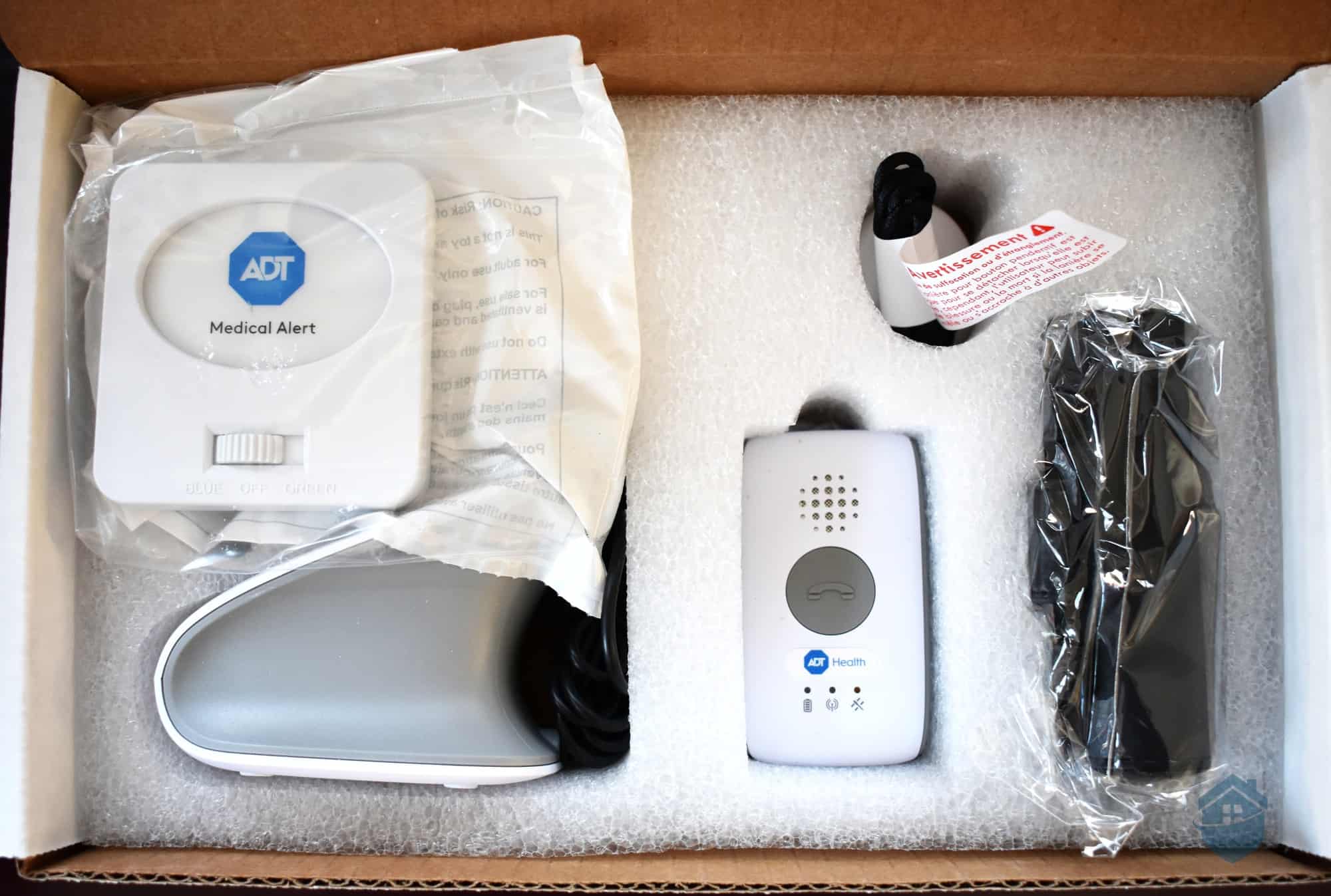
ADT Health’s On-the-Go Device In The Box
So on this particular day, as we popped open the box, we saw an assortment of devices and accessories, snug in their wrappings. The first item that we pulled from the box was the belt case for the mobile device. Our first impression was a positive one — the case looked solid and well made.
Next, we pulled out the mobile device itself. Really, this is the star of the show. It is the hub of communication whether inside your home or away. The device, boxy in shape, measures 1 ¾ inches by 3 inches by 13/16 inch (about the size of an Ivory soap bar), and it weighs 2.8 ounces. You likely won’t be bothered with this weight during a quick run to the pharmacy, but longer outings may result in some discomfort.
Note that this mobile device is not as discreet as the thin, contoured, and lightweight devices from Lifeline that we tested previously. ADT’s mobile device has both bulk and heft, but those contribute to its solid construction that doesn’t look frail and easy to break. More importantly, this is a functional device that can deliver lots of features.
The mobile device also came with an attachable lanyard and a charging station. Here’s a quick look at the goods …
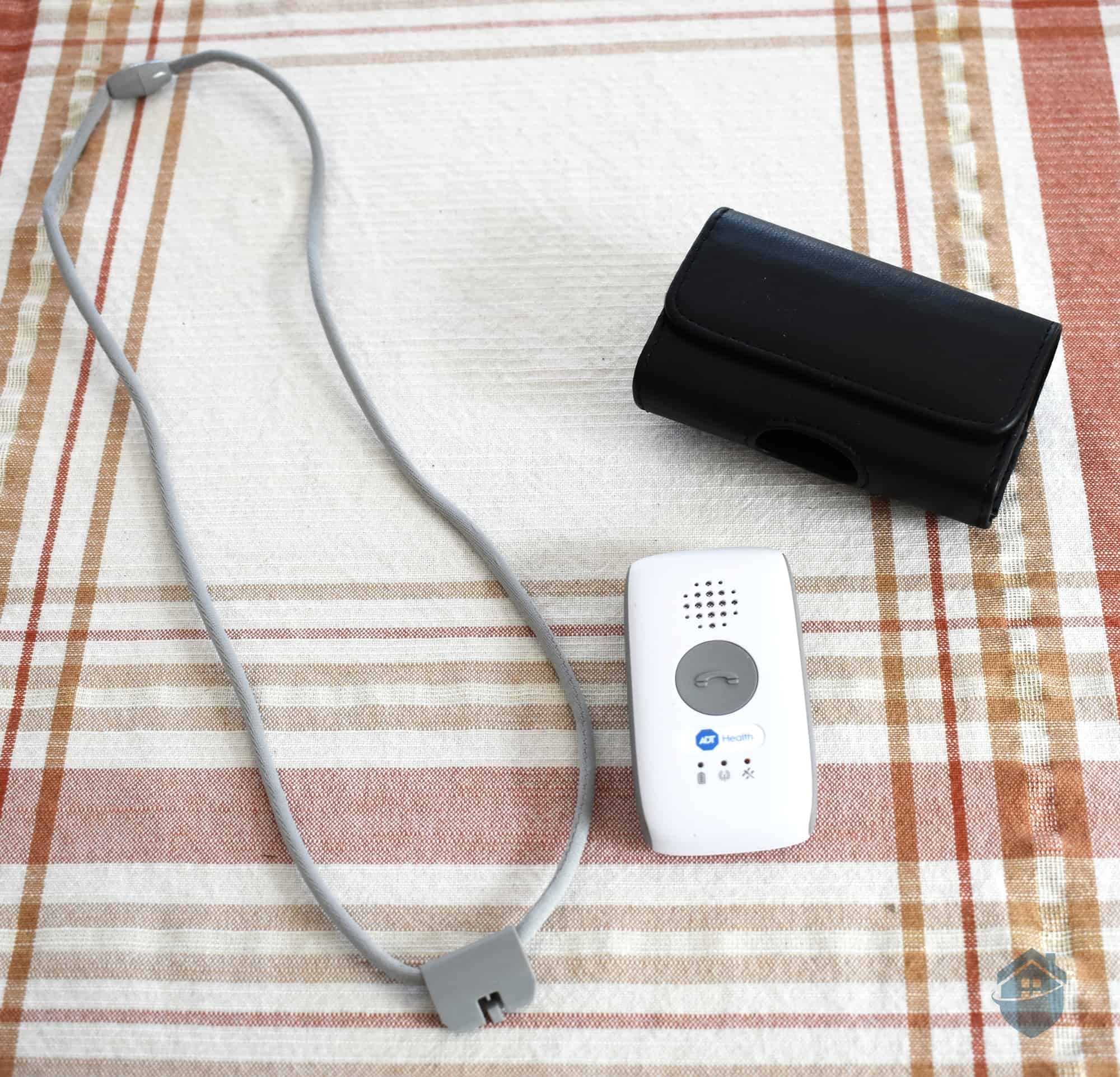
ADT Health Lanyard, Belt Case (Optional Add On), and Charging Station
Next, we unwrapped the Help Button which we had ordered with a lanyard. The idea is that when at home, the mobile device can be placed in the charging station and simultaneously used as a base unit. All communication with the Emergency Response Center will flow through the mobile device. The Help Button is much smaller, lighter and more comfortable to wear. However, as we alluded to, it doesn’t have two-way talk like the mobile device.
To give you an idea of how this works, consider a scenario where an older loved one is in the bathroom and begins to feel dizzy and nauseous. He presses the Help Button around his neck, alerting ADT Health’s Emergency Response Center that help is needed. The call goes through the mobile device which is in its charging station in the kitchen. He is unable to speak to a Response Center associate, but the Response Center receives the call for help and is able to send emergency medical services to his home.
In a nutshell, the Help Button provides coverage in an emergency but does not include the capability to cancel a call or talk through the emergency with a Response Center associate. Of course, we prefer two-way talk in mobile devices, but this is the next best thing.
FYI: Not sure if an emergency is actually an emergency? Here are a few conditions that you should always consider a reason to call for help: changes in brain function like confusion or inability to speak, shortness of breath, symptoms of a heart attack like chest pain or weakness, and severe bleeding. If in doubt, always call for assistance.1
Keep in mind that while we ordered a lanyard to use with the Help Button, black or white wristbands can also be ordered.
Now, we weren’t sure about the last item we pulled out of the box. It was square in shape with a plug on the end. When we plugged it in, it lit up blue — a nightlight! Then we remembered the “special gift” the customer service representative told us we would be receiving with our online discount.
We liked the idea of a nightlight; it’s a great safety measure for older adults, especially those who get up frequently at night to use the restroom. Just plug it into an outlet near the bed or in the hallway to help your loved one see at night. This shows us that ADT Health pays attention to the details.
To learn more about mobile medical alert systems, we suggest reading our in-depth guide on the Best Mobile Medical Alert Systems.
It was a frigid winter morning, and we didn’t look forward to putting even one toe outside the door, but we needed to pull the garbage and recycling bins to the curb. Leaving the On-the-Go device in its charger, we kept the wearable Help Button on while bundling up and heading out. This would be a great opportunity to test the device’s range.
As soon as we reached the end of the driveway, we pressed the Help Button. Sure enough, a call went through the On-the-Go device to the Emergency Response Center. We estimate we were about 50 to 60 feet from the On-the-Go device when we pressed the button.
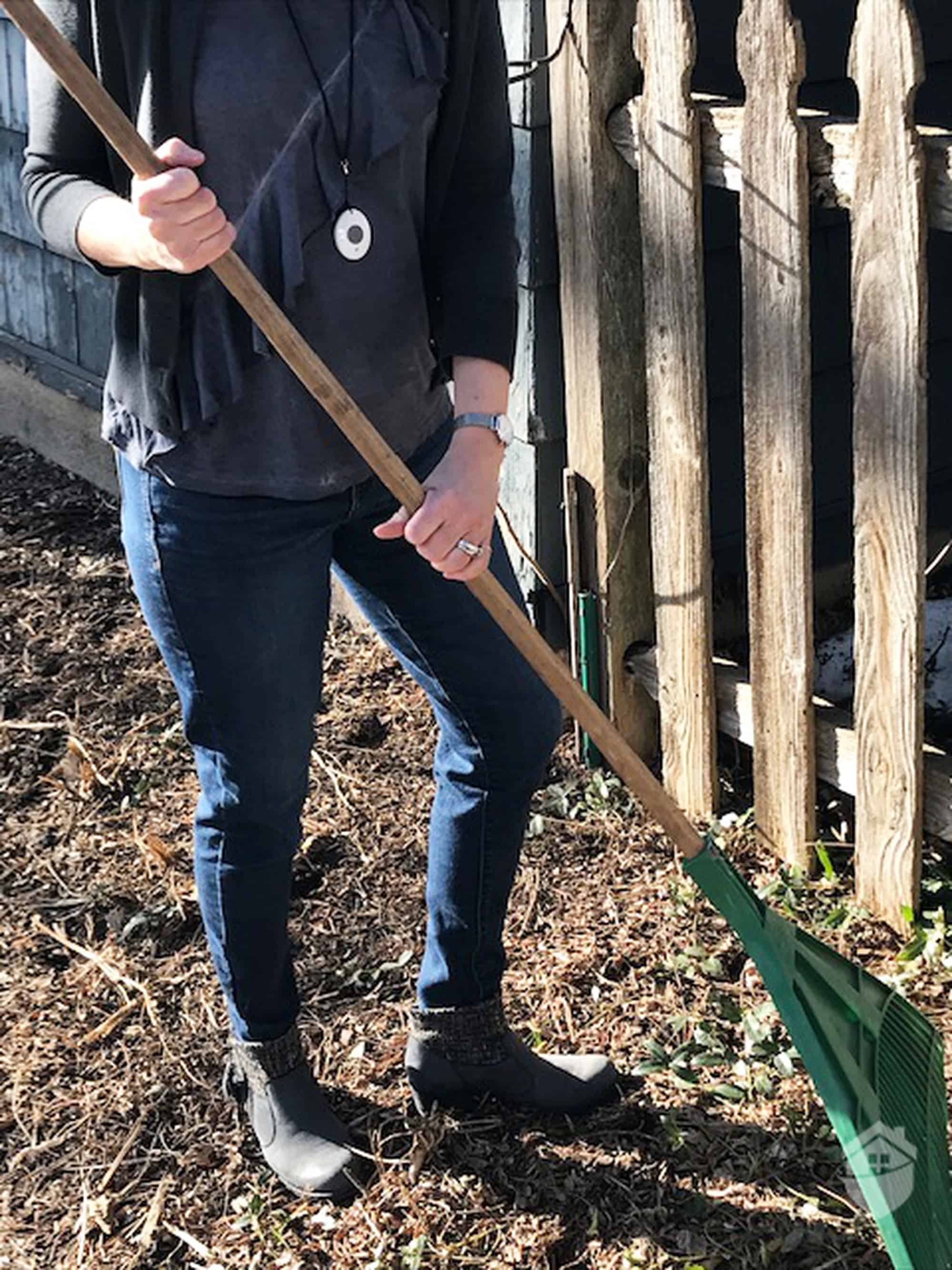
ADT Health Wearable Help Button Outside
The User Guide indicates that the maximum range between the mobile device and the Help button is 100 feet. To give you a better idea of the range, imagine yourself a punt returner in a football game. If you were returning the ball from just behind the goal line, 100 feet would get you to about the 30-yard line.
So for an average size house and yard, you will likely be able to leave the mobile device in its cradle and travel to another room or even out to your yard and remain safe with your Help Button. Think of your mobile device as your at-home base station.
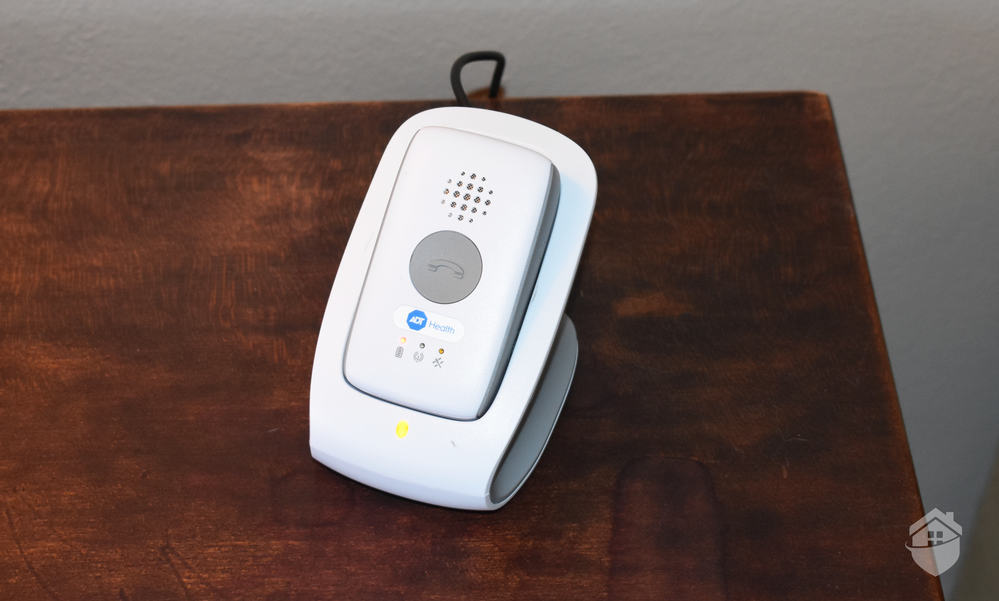
ADT Health Rechargeable Battery
Now it’s time to talk about batteries. The ADT Health rechargeable battery has a 24-hour life, so we recommend making it a habit to charge the battery every day. Much better if you can charge it at the same time every day so that it becomes a part of your daily routine. As for the best time to charge it, we’d say before going to bed. It takes three hours to charge fully. We also suggest charging it on your bedside table so that it’s within reach in case there’s a medical emergency in the middle of the night.
If you do forget to charge the battery, ADT Health has several safeguards in place. First, a voice prompt will indicate when your battery is low. Also, one of the light indicators underneath the Help button will blink red, letting you know that you have about one hour left of battery life. This same light will blink red while in the charger to let you know that the battery is still charging. The red light will turn off when finished charging.
Pro Tip: Leaving the On-the-Go device in the cradle for extended periods could damage the battery. (By extended period, we mean several weeks, not hours.) ADT Health will call you if a low-battery signal comes into the monitoring center from the unit.
Next to the light indicator that communicates battery information is a second light indicator that flashes green. When it flashes slowly, it means that the device is connected to the wireless network. Quick flashing indicates that it is not connected to the wireless network.
The third light indicator signals that the device is communicating with a GPS satellite.
Although we like strong communication, it can be difficult to memorize what those flashing lights mean. They also made us feel like a walking neon sign advertising our need for help. To be fair, we should point out that these flashing lights are pinpoints. And you can purchase an attractively designed belt case with your order that could be used for discretion.
Importantly, if you are someone with a hearing impairment, these indicators are an effective communication tool.
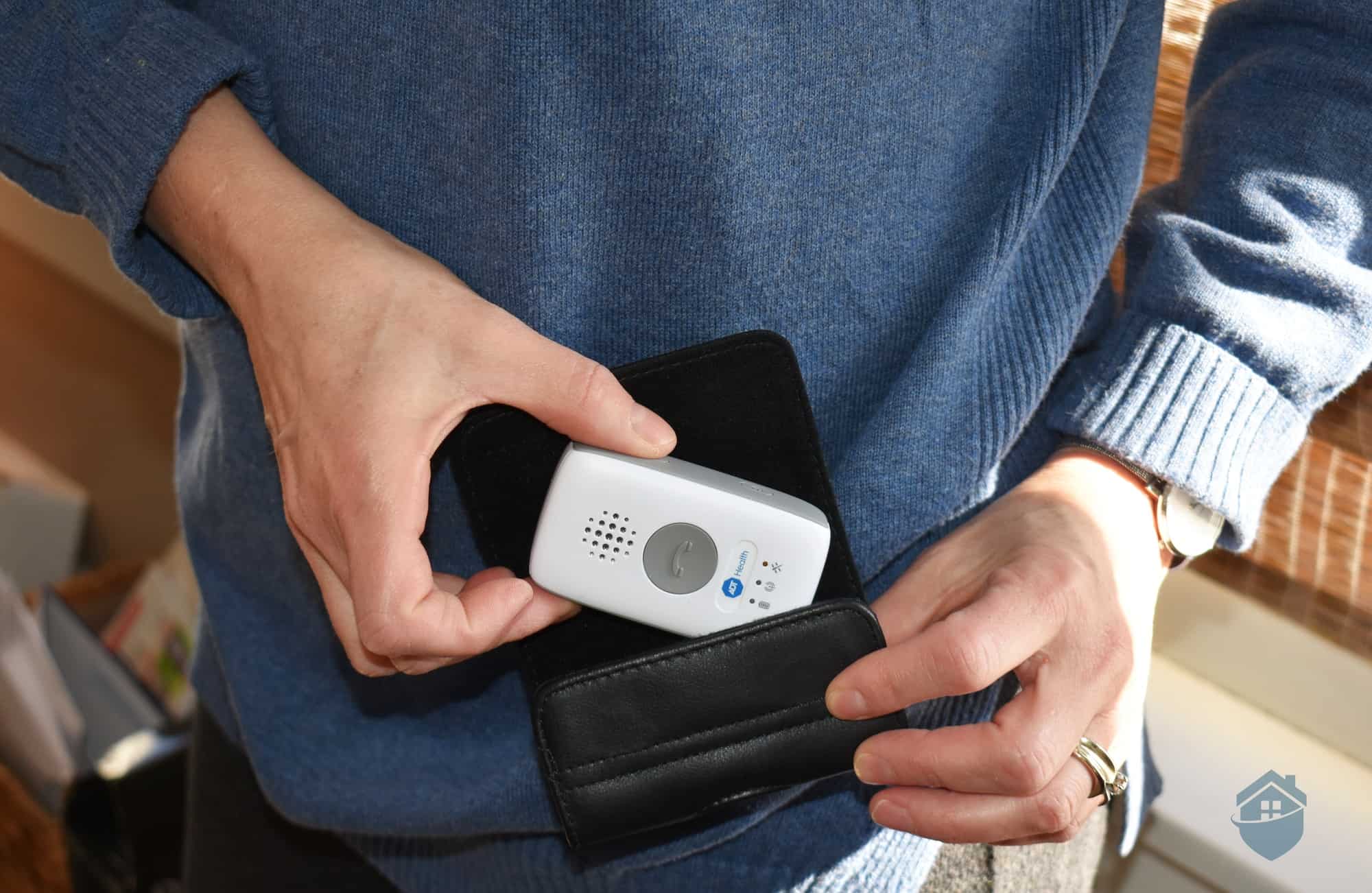
ADT Health Belt Case
However, if you are someone who is sensitive to drawing attention to your medical alert device, you might want to consider the Mini Guardian from Medical Guardian. Read about the Medical Guardian brand which includes details about this low-profile device that can be worn on either a lanyard or belt.
Pro Tip: If you or your loved one is searching for a modern alert system, we recommend checking out our full review of Medical Guardian. You’ll find lots of options that are perfect for active, fashion-conscious seniors.
Of course, the most important button on the mobile device is the Help button. And we do want to share a word of advice with you: don’t panic if you press the button and nothing happens. We did exactly this before we realized that the button needs to be held down for a few seconds in order for a call to the Emergency Response Center to go through. You will know that the call has been placed when you hear the voice prompt, “Call in Progress.”
ADT has this system in place to prevent false triggers, but we imagine this could be a downside for someone with achy wrist joints or arthritis. Check out our Bay Alarm review for an on-the-go system with a much easier alert mechanism.
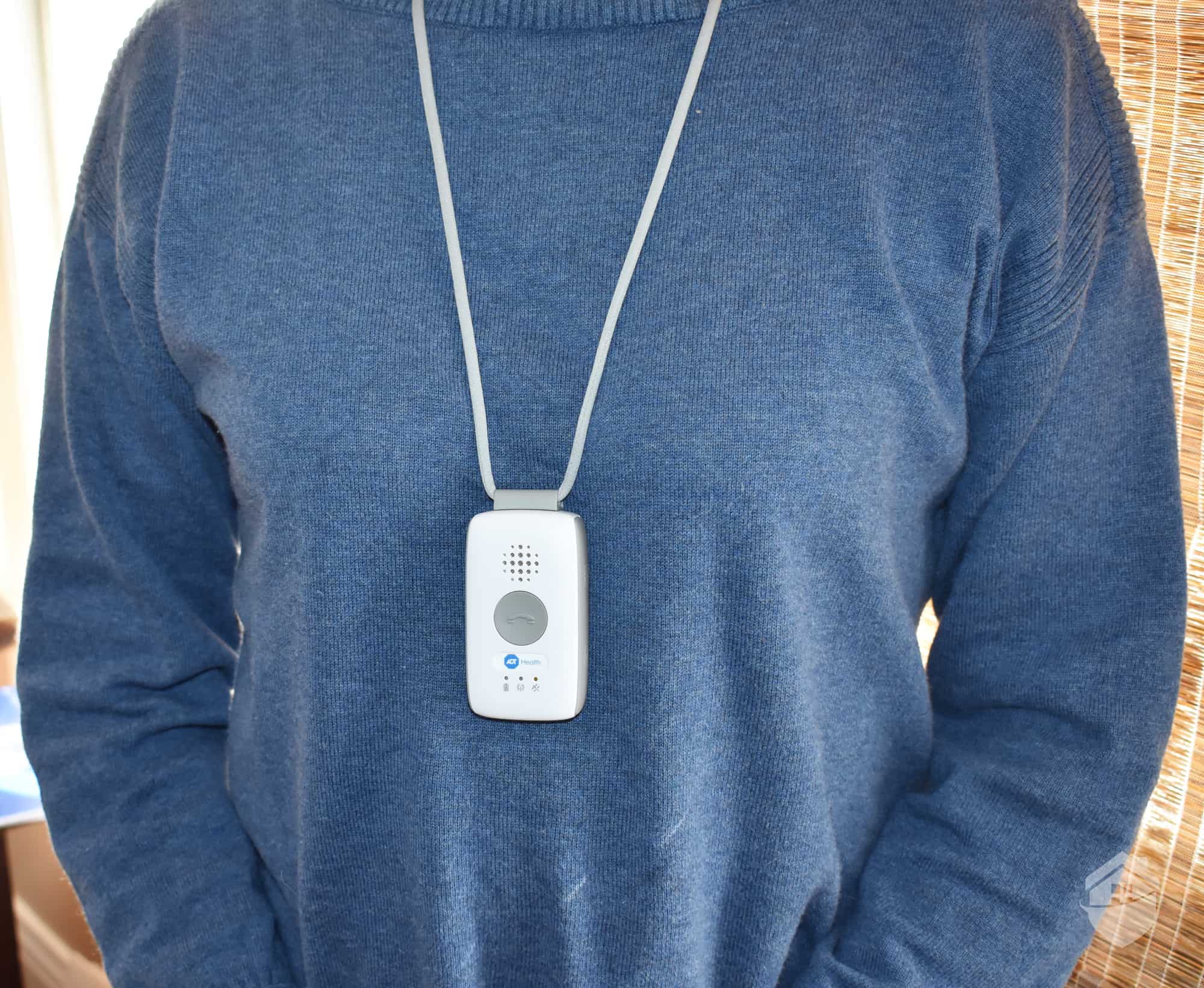
ADT Health Wearable Help Button
Besides calling for help, the mobile device has a few other important features, particularly for when you’re out and about. GPS-enabled location detection allows the Response Center to pinpoint your whereabouts in the case of an emergency. For example, if growing confused about your whereabouts because of dementia or another medical condition or injury, the Response Center would be able to immediately determine your location and send help.
Pro Tip: It’s a good idea to regularly test your system. Do realize that the mobile device will not transmit more than one emergency call within two minutes.
In addition, the mobile device includes two-way talk. This function helps a Response Center associate understand an emergency situation and allows them to provide emotional support until aid arrives. It also enables you to cancel an emergency call if you change your mind or accidentally press the Help button.
One of the most important measures of an effective medical alert system is the response time, or the length of time between pressing the Help Button and connecting with an Emergency Response Center associate. Note that the industry average response time is between 30 and 40 seconds.
We tested ADT Health’s response time a total of five times. Two of these calls came in around the industry average — 31 and 42 seconds. A third call had an excellent response time of 23 seconds, which is faster than average. And two other calls came in slower than average — 85 and 91 seconds. So the results were a bit inconsistent. ADT Health’s response time for our tests averaged out to 55 seconds, which isn’t great, but only slightly slower than the industry average.
Here’s a short video we made testing the ADT Health alert system: (Note the impressive 23-second response time.)
FYI: ADT Health uses AT&T’s cellular network for its On-the-Go device. So you can travel anywhere you please with it, just as you do with your own cell phone.
One of the newest technologies that has been incorporated into medical alert devices is fall detection. As the name implies, a device with fall detection has sensors that recognize movement indicative of a fall and immediately send an alert to the Emergency Response Center.
Before learning about ADT Health’s fall detection, you may be interested in reading our overview of Best Medical Alert Systems with Fall Detection.
We think it is important to recognize that one of the best fall protection strategies is to prevent falls from happening in the first place. This may include exercise to build strength and muscle and improve balance. It means ensuring good eyesight through frequent vision checks. And it involves eliminating hazards from your home such as unsecured rugs and clutter.2
FYI: Preventative measures can go a long way, but unfortunately accidents and medical emergencies that precipitate falls still happen. And when they do, it is important that a fall is identified and help is sent — immediately. The quicker assistance arrives, the better the chances of a loved one’s physical and emotional recovery.
Some mobile devices incorporate fall detection within the device, not requiring an additional pendant. ADT Health offers a pendant, similar in appearance to its Help Button. So this pendant takes the place of the Help Button while at home. One thing to note is that while the Help Button without fall detection can be worn on the wrist or around the neck, the Help Button with fall detection can only be worn around the neck. That’s the most effective way of wearing it to ensure the fall detection feature activates when needed. You’ll find that most medical alert buttons with fall detection require to be worn around the neck, not just ADT.
When on the go, you would need to wear the pendant while also wearing the mobile device. We think that carrying two separate devices can be cumbersome and prefer a more streamlined approach with a single device. However, no system is perfect, and with this one we would recommend wearing the mobile device in the belt case or carrying it in a purse, while wearing the pendant around your neck.
Pro Tip: ADT occasionally runs specials on fall detection, offering a $5 discount on what is typically a $11 fee.
In addition to their On-the-Go system, ADT Health offers two at-home systems: Medical Alert Basic and Medical Alert Plus. If you or your loved one uses a landline, the basic system is a good (and cost-effective) option. It includes a base unit with two-way talk and a Help button that can either be worn with a lanyard or a wristband. The Help button operates within a 300-foot range of the base unit.
The Medical Alert Plus system also includes a base unit along with a Help button. One of the main differences between the two systems is that Medical Alert Plus uses a cellular connection. Also, with a longer range of 600 feet, the Help button extends coverage to areas such as the garden or backyard.
One unique feature that you will find on both of ADT’s at-home base units is home temperature monitoring. This is a useful extra for both the subscriber and the caregiver.
ADT Health provides a few incentives that will pad your pocketbook. You will not be required to sign a long-term contract or pay an equipment fee. In addition, ADT Health offers what they call their “ForeveRate Guarantee,” a price lock that will never change. Finally, you won’t see any hidden fees, and one-day shipping is provided free of charge. We love these customer-friendly policies.
One other way to save money is by using ADT Health’s quarterly or annual payment plans. You can save up to $50, plus ADT throws in a free lockbox.
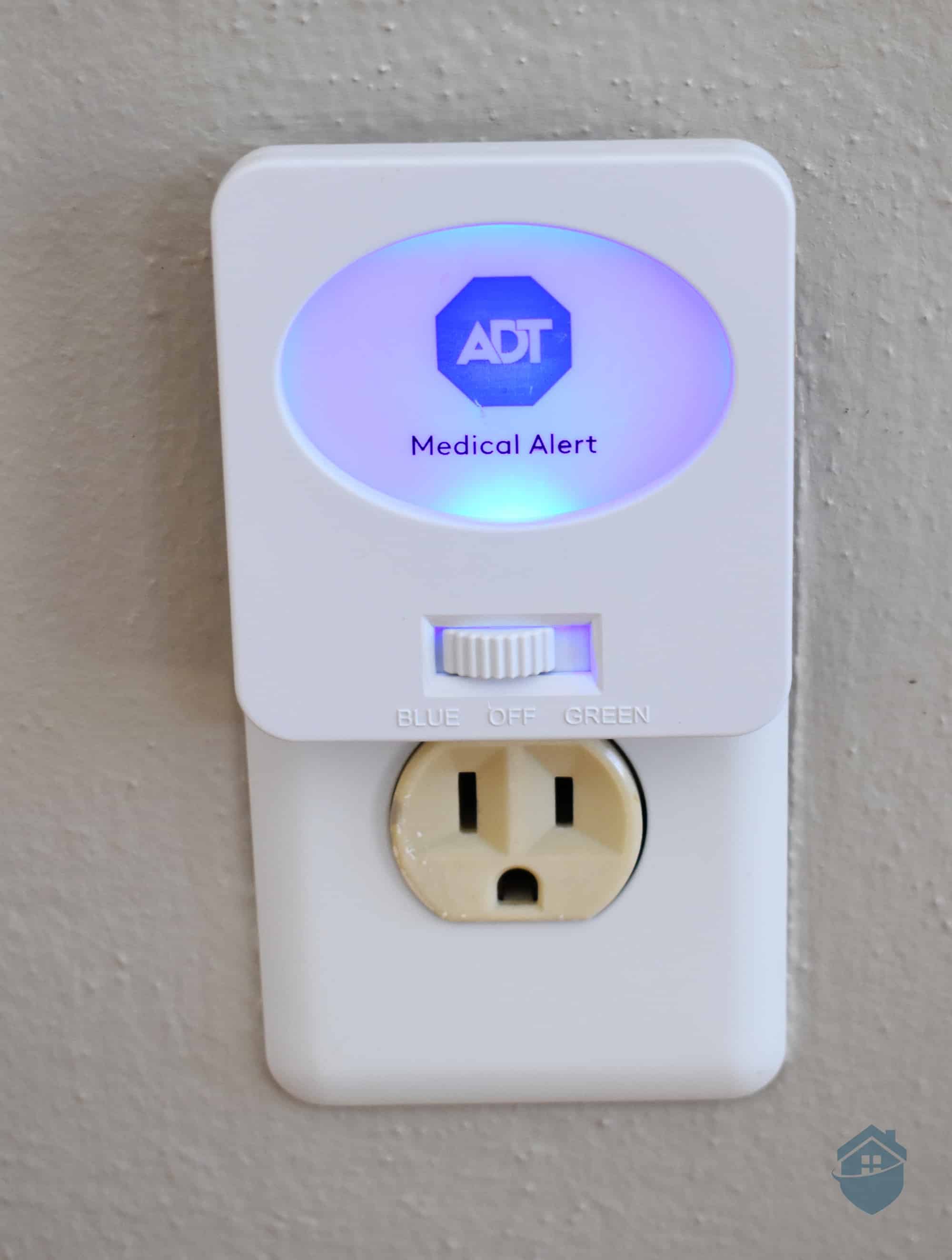
ADT Health Wall Plug
| ADT Medical Alert Systems | Monthly Plan Cost | Equipment Fee |
|---|---|---|
| Medical Alert Basic | $29.99 per month | $0 |
| Medical Alert Plus | $37.99 per month | $0 |
| On-The-Go | $39.99 per month | $0 |
Pro Tip: Read our full guide to ADT Health packages and pricing to see if this alert system is right for you or your loved one.
Having reviewed several mobile devices, we find that most systems charge a monthly fee between $35 and $50. So we think that ADT Health’s $39.99 per month fee is a pretty affordable rate.
For a look at another system with a variety of economical packages, take a peek at Bay Alarm Medical. We also recommend reading Best Affordable Medical Alert Systems.
Most medical alert systems offer a list of extra features that can be added to customize your device.
ADT Health keeps it relatively simple. They offer five add-on options, but these are likely the most popular options out there.
The first is fall detection (which we talked about earlier). Most medical alert systems offer this feature as an add-on with an additional monthly fee between $5 and $10. The only exceptions are those systems that embed the cost of fall detection within what is usually a more expensive monthly fee. ADT Health charges $11 per month, in line with industry standards.
Another option is a lockbox, a safe means of storing a key in the event that first responders need to quickly enter your home without damaging your property. ADT Health will securely store your code so that Response Center associates can access it if an emergency were to occur. A lockbox will cost you $29.99, a one-time expense. Remember that if you opt for a quarterly or annual (rather than monthly) payment plan, ADT Health will throw in the lockbox free of charge.
Other extras include an additional wearable help button for a flat fee of $14.99 plus an additional $5 monthly fee, a waterproof wall mount button for an additional $2.99 monthly fee, and a leather on-the-go carrying case for a flat fee of $10.
Factoid: A tool that emergency services often use to break through a locked residential door is called a Halligan bar, which combines a blade, a claw, and a pick.3 As you can imagine, the use of this sometimes necessary tool will cause damage to a property. So it is always a good practice to provide access information to the Medical Alert Response Center.
In comparison to other medical alert systems, ADT Health offers few customization options, keeping it simple. What you see is what you get.
We found the Emergency Response Center associates to be efficient and polite. ADT Health owns and operates five monitoring centers throughout the United States. This is good to know. If one were to go down because of say, bad weather, we would still be covered by one of the others.
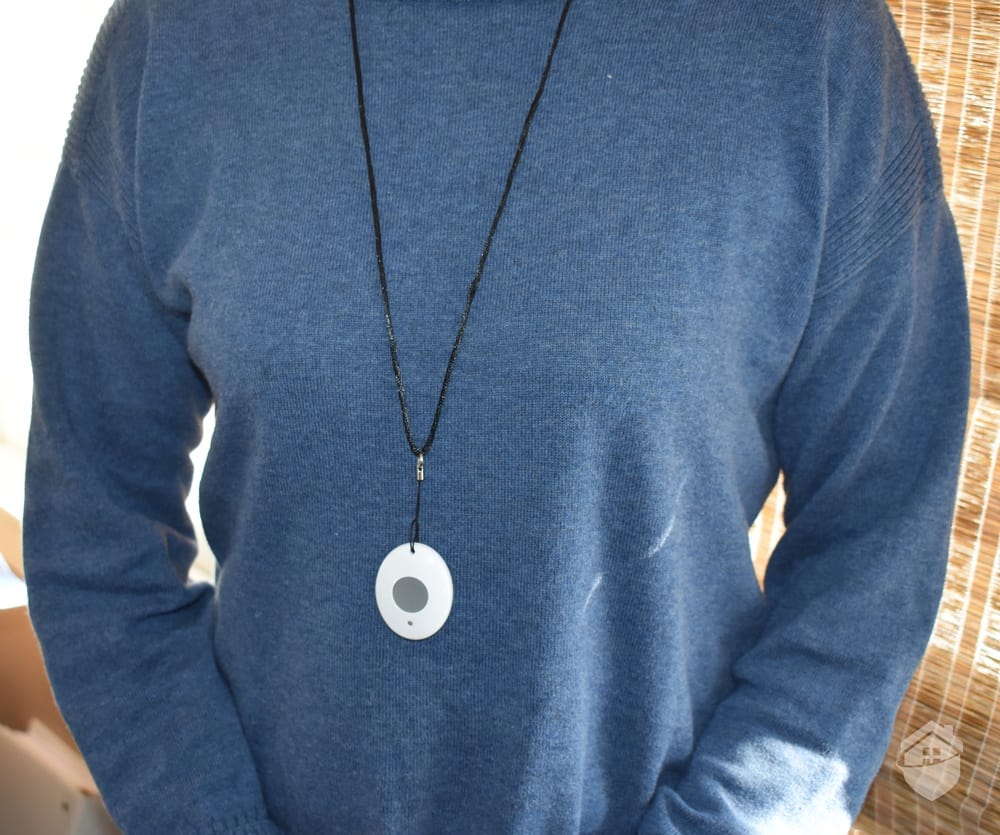
ADT Health Wearable Help Button
The customer service representatives were equally friendly. One of them, Andre, even called us a few days after our system had arrived to ask how the system was working and who we’d like included on our list of contacts.
Since we had him on the phone, we decided to ask Andre a few questions about the system. He did his best to answer our questions, but ultimately told us that as a member of the activation team, he didn’t have the information we needed. So just keep in mind that any issues that arise with your system may require some patience to iron out. No biggie.
ADT has been in the business of providing security for 145 years. We’ll do the math for you — that means they got started in 1874. We couldn’t imagine what kind of security they were providing. Vigilantes on horseback keeping watch of the neighborhood?
ADT was formed after its founder, Edward Callahan, invented a “callbox,” a telegraph-based contraption that could be used to call for assistance. The creation was inspired from a local break-in, and he soon connected 50 other homes in the neighborhood to the system, thus founding the first residential security system. Today, ADT is mostly recognized for its home security systems.
After years of continuing to develop and improve this system, including the creation of 24/7 monitoring through a Central Monitoring Center in the early 20th century, it was a logical next step to diversify into medical alerts for older adults. ADT Health’s medical alert monitoring division began in 2004.4
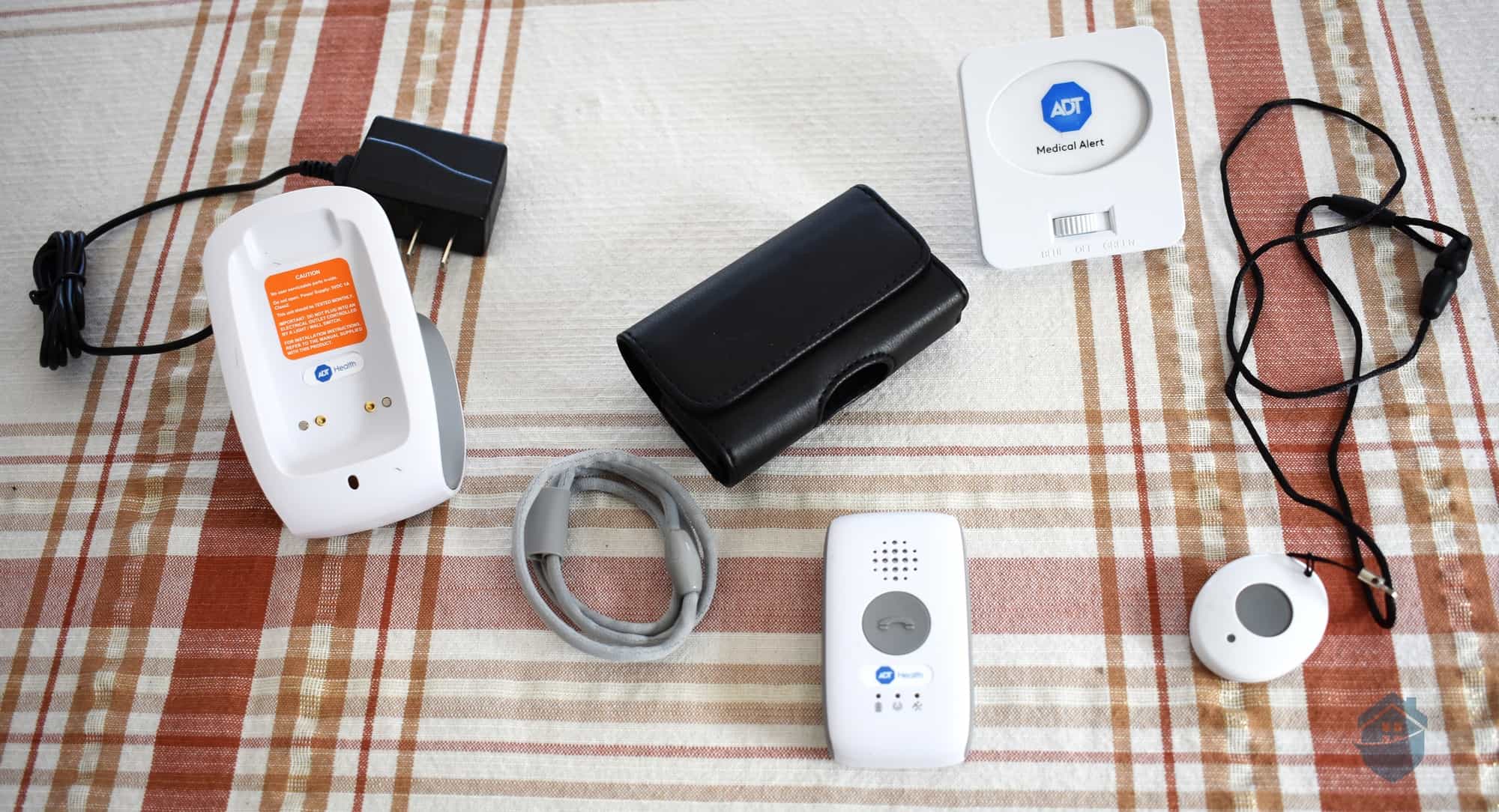
ADT Health’s On-the-Go Device Unboxed
If it’s a basic, affordable medical alert system that you want, made by a name you can trust, ADT Health’s On-the-Go is a solid option.
We liked the easy setup and simplicity of this system. We definitely think it is a system that older adults will be able to use without a steep learning curve. At the same time, it includes all of the most important features we like to see: two-way talk, location detection, and optional fall detection.
As we see it, the biggest drawback to the system is a lackluster average response time of 55 seconds. These extra seconds can really make a difference in the event of an actual emergency.
Also, there aren’t a whole lot of bells and whistles with ADT Health. But then again, not everyone needs (or wants) fancy features. So overall, we think that ADT Health is worth the money. It provides plenty of functionality at a cost-effective price.
The mobile device is water-resistant. It can be used in the shower but should not be submerged.
The system can move with you. Contact ADT Health at least 30 days prior to your move so that the company can transfer the system. Also, note that you may be charged a fee.
ADT Health does not offer a free trial period. They will reimburse any unused days in the monthly billing cycle upon return of the equipment. They also send a prepaid mailing label that can be used to return the devices.
While traveling by air, you will need to turn your device off. This can be done by pressing the on/off button on the lower side of the device.
Yes, a lifetime warranty covers parts, labor, and service for normal wear and tear. It doesn’t cover lost or damaged items.
Verywellhealth.com. (2020, February 6). How to Recognize a Medical Emergency.
https://www.verywellhealth.com/how-to-recognize-a-medical-emergency-1298541
ADT.com. (2020). Senior Independent Living Guide.
https://www.adt.com/content/dam/adt7/downloadable-pdfs/ADT_Health_Independent_Living_Guide.pdf
StatPearls Publishing. Retrieved from National Center for Biotechnology Information. (2020, May 8). EMS Gaining Access and Extrication.
https://www.ncbi.nlm.nih.gov/books/NBK482471/
ADT.com. (2021). Our History. https://www.adt.com/about-adt/history